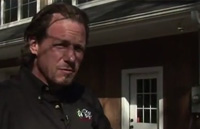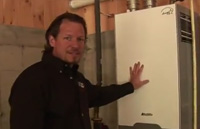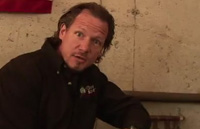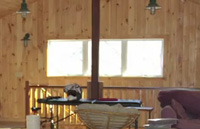Energy Efficient Barn With Radiant Heated Floors, Tankless Boiler and Spray Foam Insulation
This homeowner wanted to build an ultra energy efficient heated barn, comfortable enough to be used as a recreation room or extra living space on the weekends, and not too costly to maintain.

Ultra Energy Efficient Heated Barn
Today we were called out to help a homeowner whom we were able to help several years and the homeowner wants to put a little addition on the back of this tractor shed which is probably 50 years old or more and they want to build a 2-story barn here that is heated.

Tankless Boiler Installed
So let's take a look at the tankless wall mounted boiler, its very efficient and in this case its propane although it could be natural gas. We have a PVC exhaust and a PVC intake for the combustion air so qualities of high efficiency heating equipment are that it doesn't take air for combustion from inside the building, instead it has dedicated air for combustion from outside and it squeezes all the heat out of the combustion gases sending so little heat up the chimney which in our case is PVC that its very high efficiency.

Radiant Heated Floors Installed
We have a circulator here for the radiant heat loops that we put in the slab so during new construction we insulate on top of the soil and then run these loops throughout the slab so during new construction we insulate on top of the soil and then run these loops throughout the slab that the hot water will go through and then we pour the concrete and cast the concrete so that those radiant heat loops are inside the concrete.

Heated and Efficient Space
The second floor of this semi-finished barn and the homeowner wanted a heated, high efficiency space so we have the baseboard radiators which run off out high efficiency and the roof and the walls are super insulated with spray foam insulation.
Read Full Transcript
Hi, I'm Larry Janesky of Dr. Energy Saver; today we were called out to help a homeowner whom we were able to help several years and the homeowner wants to put a little addition on the back of this tractor shed which is probably 50 years old or more and they want to build a 2-story barn here that is heated. Now the homeowner doesn't use the barn too often, just mostly on the weekends and he wanted to be very energy efficient because he wanted to keep it heated yet not waste a lot of fuel doing so. We were called to advise the homeowner and do the work that is necessary during construction. So what we wound up doing was installing a radiant heated floor with a wall mounted tankless boiler which provides hot water to the bathroom, upstairs radiators, baseboard radiators, the radiant heat in the slab of the first floor and spray foam insulation to make the barn ultra efficient like a big thermos. So let's take a look at the tankless wall mounted boiler, its very efficient and in this case its propane although it could be natural gas.
We have a PVC exhaust and a PVC intake for the combustion air so qualities of high efficiency heating equipment are that it doesn't take air for combustion from inside the building, instead it has dedicated air for combustion from outside and it squeezes all the heat out of the combustion gases sending so little heat up the chimney which in our case is PVC that its very high efficiency. In fact 96% efficient and so we only have 4% of the heat that we paid for with the propane delivery going out the chimney. In addition we have variable speed circulators like this boiler and it makes hot water and we have a circulator here that goes to the upstairs to run the baseboard heat on the second floor of this barn. What is a variable speed circulator mean? Well it means that if we only need a little bit of heat it will run the hot water through those baseboards slower and when we need a lot of heat it will run that water through those baseboards faster.
We have a circulator here for the radiant heat loops that we put in the slab so during new construction we insulate on top of the soil and then run these loops throughout the slab so during new construction we insulate on top of the soil and then run these loops throughout the slab that the hot water will go through and then we pour the concrete and cast the concrete so that those radiant heat loops are inside the concrete. So what we're doing here is heating up the slab not to a very high temperature but there's enough thermo mass here that if we heat up this slab to 80˚ or so - boy we're going to have a really toasty barn because it's like the entire floor system is a radiator. In addition when we open the garage doors, the overheated doors that we have here in the lower floor of this barn we don't lose all of our heat.
If we had a furnace that heated the air well and we open the overhead door for five minutes on a cold day all the heat escapes and when we close the door the furnace has to start all over again. With radiant heat in a slab the slab is warm and so yes the warm air will go out but the recovery rate is pretty quick because we have a lot of thermo mass that's already warm. We're also making hot water for a bathroom upstairs and there's a sink down here and so this system makes hot water for that as well. Here we are in the second floor of this semi-finished barn and the homeowner wanted a heated space and a high efficiency so we have the baseboard radiators which run off out high efficiency and the roof and the walls are super insulated wit spray foam insulation. Spray foam insulation which can be installed in the roof and new construction will air seal the building so no air can leak out of the building and also insulates to an incredible R-7 per inch for closed cell foam.
Opened cell foam is about R-4 and a half per inch but closed cell foam of choice. In the several years since we did the high efficiency heating system in the barn for this homeowner he's finished the inside with this beautiful knotty pine tongue and grove treatment but one space that he didn't do is underneath the stairs here where we can still see the 2-part foam insulation that's inside the walls. These are 2ˣ6 walls and there's 3 inches of foam with R-7 per inch makes R-21 walls. However more importantly these walls are air sealed and air can't go through them so the combination of air sealed walls and a roof with high insulation R-value gives us a barn that's very easy to heat, holds heat very well, its like a big thermos. What are the results? An 1800-square foot building that costs less than $400 a year to keep heated.
If you'd like to make your home more comfortable, fix rooms that are too cold in the winter or rooms that are too hot in the summer, if anybody in your household has allergies, if you have excessive dust in your house; these are all things Dr. Energy Saver can help you with and lower your cost of homeownership by reducing your heating and cooling bills. Call Dr. Energy Saver, we'd love to help you.
our service area
We serve the following areas
- Albion
- Alexander
- Avon
- Batavia
- Bergen
- Bloomfield
- Brockport
- Byron
- Caledonia
- Churchville
- Conesus
- Dale
- Dansville
- East Bethany
- Elba
- Geneseo
- Groveland
- Hamlin
- Hemlock
- Henrietta
- Holley
- Honeoye
- Honeoye Falls
- Kendall
- Kent
- Lakeville
- Le Roy
- Leicester
- Lima
- Linwood
- Livonia
- Mount Morris
- Mumford
- Naples
- North Chili
- Nunda
- Oakfield
- Pavilion
- Perry
- Piffard
- Rush
- Scottsburg
- Scottsville
- Spencerport
- Springwater
- Stafford
- Waterport
- Wayland
- West Henrietta
- Wyoming

